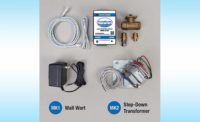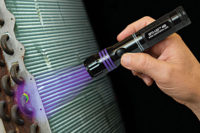Plumbing leak detection technologies with automatic shutoff have been available for years. But recently, more customers are demanding devices and a greater number of brands are entering the market. The leak detection category has seen exponential growth because today, leak detection is more than a smart way to protect property and prevent water waste — for many, it’s a necessity.
Leak detection installation and sales are something plumbing contractors and suppliers who keep up with the marketplace can’t afford to ignore. The primary growth driver: For many homes and businesses, to get insurance or maximize insurance premium rate discounts, a leak detection auto water shutoff device is now a requirement.
Increased demand
The reason why leak detection is becoming mandatory is evident in the numbers. Plumbing leaks are a leading cause of property damage. In fact, more than $13 billion in insurance claims are filed in the U.S. annually because of water damage. For insurers with a specialty focus on high value properties, water damage is the leading category of claims, with the average claim payout approaching $60,000. So as insurance has promoted smoke detectors and security systems for years, they are now doing so for leak detection with automatic shutoff. Plumbing leak damage, after all, is many times more likely to occur than fire or burglary losses. If a device isn’t required as a condition of insurance coverage, often discounts for installing them are so rich that they pay for the device in short order.
With the new demand for leak detection technologies, supply houses play an important role in helping plumbers and homeowners get the device that is best suited to meet requirements. For most insurers who require a device, the minimal standard is whole house, flow-based leak detection with automatic shutoff. Some insurers will provide premium discounts for properties that have point of leak detectors (those which alert users to the presence of water in a specific location). But increasingly, when leak detection is required, a device that is among a short-list of vetted, flow-based detectors is all they will accept.
Understanding the technology
If you’re like many pros in the plumbing industry, you still may not have a clear understanding of how flow-based leak control technologies work. You may not know how to answer a common question: How do these devices tell the difference between a leak and my morning shower? Having a basic understanding is important for anyone selling or installing these technologies. The answer can be summarized easily: Flow-based detectors operate by watching water use throughout a property. Normal water use is episodic, whereas leaks create continuous flow. So flow-based detectors see abnormal flow durations as possible leaks, respond to shut off the water automatically, and then alert users through an app or text message. And because they’re installed on the main line where water enters the property, they can detect and stop leaks no matter their location, in properties of all sizes. Home/Away modes and settings adjustments offered by some systems help ensure property is protected, while normal water use isn’t mistaken for a leak.
General knowledge of the most popular flow-based technologies available and understanding the drivers to purchase will equip plumbing supply pros to sell the right equipment for the job. Supply houses can help customers understand which device holds the best benefits for a plumber’s business and a homeowner’s lifestyle.
What to tell your customer
For customers who are keenly interested in knowing how much water they’re using, one of the metering devices may be a good candidate. These systems recognize real-time flow, using one of several technologies that are commonly found in domestic water meters. Once water flow reaches their minimal detectable flow rate, they can tell users how much water is flowing in real time and they can provide total usage reports by day, week and month. Some of these devices even provide estimates of usage by appliance. Metering devices cannot see real-time flow in lower flow volumes, so most have scheduled pressure decay tests where water is shut off and a pressure gauge on the structure-side of the line will notice smaller leaks by seeing the pressure drop. In certain parts of the country where water is scarce or anywhere a customer is conservation-minded, these metering devices offer a dual benefit of protection and water use insights. And these devices have a lower price point compared to other devices, which can appeal to the homeowner who is simply trying to spend the least amount possible to satisfy an insurance requirement.
For customers who are focused primarily on home security, or those who have large homes with complex plumbing architectures, a higher-end flow-based system may be the best solution. These systems are capable of seeing large leaks and small pinhole leaks, the moment they begin, without pressure decay tests, are available for larger pipe sizes and have the ability to directly integrate with irrigation, water treatment and pool systems, to distinguish their extended water usages from a leak. While these systems aren’t equipped with metering technology, they appeal to a customer base who is focused on no-compromises fortification of their home and those who aren’t planning on engaging regularly with water consumption data. With their higher price-points comes more comprehensive flow-sensing technologies, valve-body construction consistent with industrial-grade water valves and longer customer warranties. Higher prices also typically mean greater margin opportunities for re-sellers.
Armed with knowledge of why customers typically seek leak detection devices and understanding the basic types of devices that are available, plumbing supply house pros can readily recognize which brand will best meet the needs of the end customer. And since many plumbing pros have limited experience with selling or installing leak detection devices, you can help your pro customers adopt a profitable new product category for their businesses.
Some plumbing contractors can be intimidated at the first thought of working with smart leak detection technology. But supply house pros can help demystify the products and what it takes to install them. After all, any plumbing contractor who can do basic piping and install a manual shutoff valve will have the skills to install any smart leak detection valve. As the devices more commonly become necessary for homeowners to insure their properties, you can help the industry meet this demand one customer at a time. You can be a catalyst for growing leak detection category sales for your supply house and throughout the industry, because as the marketplace is dictating, they are no longer just a nice-to-have.





